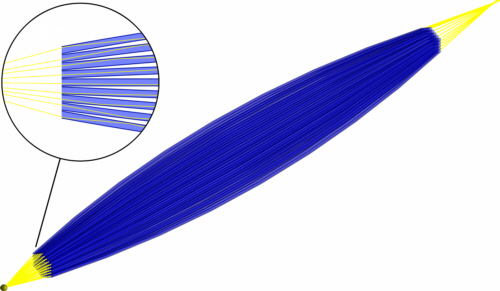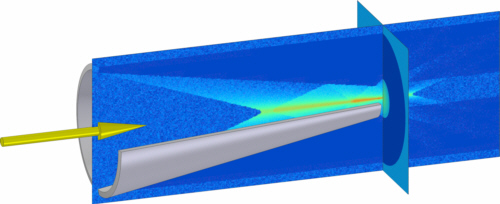La óptica de capilares suele consistir en capilares de vidrio. La tabla 1 ofrece una visión general de los parámetros típicos de la óptica capilar.
| Parámetros | Símbolo |
Valores típicos | Comentario | |
| Monocapilares | Policapilares | |||
| Diámetro del haz |
du or |
0.01-20 mm | 0.1-20 mm | |
| Diámetro del foco | dcapillary | 0.25-1000 µm | 6-1000 µm | |
| Diámetro de la superficie de entrada | D1 | 0.01-20 mm | 0.1-20 mm | |
| Diámetro de la superficie de partida | D2 | 0.01-0.2 mm | 0.1-20 mm | |
| Aumento de la intensidad radiante | KΘ | 5-50 | 10-100 | KΘ=τ(ΔΘE/ΔΘA)2 |
| Longitud del capilar | Lcapillary | 10-1000 mm | 10-1000 mm | |
| Distancia de trabajo de entrada | rcap,1 | ∞-0.1 mm | ∞-3 mm | |
| Distancia de trabajo de salida | rcap,2 | 0.1-∞ mm | 3-∞ mm | |
| Aceptación del ángulo de entrada | ΔΘE | 0.01-0.25 rad | 0.01-0.25 rad | ΔΘE=2 arctan(D1/(2r1)) |
| Divergencia de salida | ΔΘA | 0.01-0.25 rad | 0.01-0.25 rad | ΔΘA=2 arctan(D2/(2r2)) |
| Divergencia del haz cuasi-paralelo (para policapilares) | ΔΘA | 0.0005-0.001 rad | 0.001-0.005 rad | |
| Aumento de la intensidad | K | 5-1000 | 500-20000 | |
| Transmitancia espectral | τ(λ) | 0.1-0.9 | 0.05-0.6 | |
Table 1: Parámetros típicos de la óptica capilar [VDI 2009b]
Ópticas policapilares
En la óptica policapilar (también conocida como lentes de Kumakhov), los rayos X se guían por reflexión externa total en un haz de capilares de vidrio curvados y estrechos (Fig. 1), [Kum 1992]. Los capilares del haz están curvados de forma que un lado de cada capilar individual apunta a la fuente de luz y el otro lado del capilar apunta al punto focal. Los policapilares no mapean la fuente de luz en el punto focal en el sentido de una imagen óptica: la luz sale de los capilares con el mismo ángulo de divergencia con el que entró en el capilar. Desde el extremo de cada capilar, la luz diverge con este ángulo de divergencia (normalmente igual al ángulo crítico de reflexión externa total). Por tanto, el punto focal sólo resulta de la alineación de los capilares con el punto focal. El punto focal no aumenta si se incrementa el diámetro de la fuente. Los policapilares son ópticas de iluminación y no son adecuados para la formación de imágenes ópticas.

Fig. 1: Conducción de la luz en una óptica policapilar; foto de una policapilar 
Monocapilares
En un monocapilar, los rayos X se reflejan en un único capilar de vidrio por reflexión externa total desde la fuente de luz hacia el foco. El interior del monocapilar tiene la forma de un elipsoide rotacional o de un paraboloide rotacional. La fuente de luz se coloca en uno de los dos puntos focales del elipsoide o en el punto focal del paraboloide. La luz se proyecta en el segundo punto focal del elipsoide o se colima en el caso del paraboloide. A la inversa, un haz de luz que incide paralelo al eje óptico también puede enfocarse. En todos los casos, cada haz se refleja exactamente una vez en el interior de la óptica monocapilar. Por tanto, esta óptica no cumple el criterio de Abbé, lo que significa que la óptica no es adecuada para enfocar una fuente de luz extendida. Desde hace algunos años existen también monocapilares cuya cara interior tiene forma de óptica de Wolter. Estas ópticas son adecuadas para la formación de imágenes.

Fig. 2: Monocapilar; los haces perdidos se resaltan en rojo al pasar el ratón sobre la imagen. 
Capilares cónicos
La óptica capilar cónica consiste en un capilar ligeramente cónico internamente con paredes internas muy lisas. El ángulo de apertura máximo admisible del cono depende del ángulo crítico de reflexión total externa del material de la pared con la energía fotónica utilizada. La luz incidente se refleja una o varias veces por reflexión interna total externa en las paredes interiores del capilar. Estos capilares suelen ser de vidrio, pero también pueden ser de otros materiales. La óptica no produce un foco puntual pronunciado, sino una línea de intensidad creciente sobre el eje óptico en el extremo del capilar (Fig. 3, en la que la conicidad es extremadamente exagerada). Estos capilares tienen un diseño sencillo, pero sólo presentan distancias de trabajo muy pequeñas y carecen de propiedades de formación de imágenes.

Fig. 3: Capilar cónico con distribución de intensidad simulada 
| [Kum 1992] | M. A. Kumakhov and V. A. Sharov, A neutron lens, Nature vol. 357, pp. 390-391, DOI: 10.1038/357390a0, 1992 |
| [VDI 2009b] | VDI/VDE 5575 Blatt 3: 2009-02 Röntgenkapillaren (X-ray optical systems; Capillary X-ray optics), Berlin, Beuth Verlag, 2009 |


